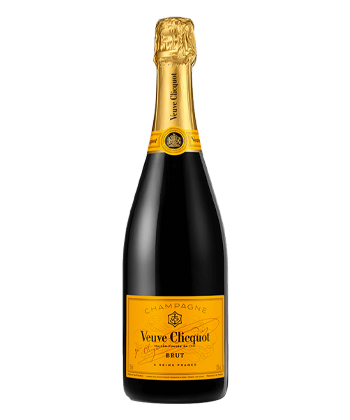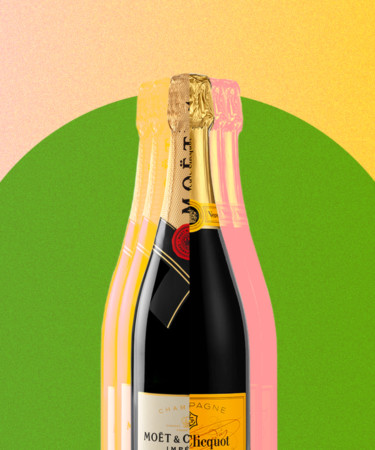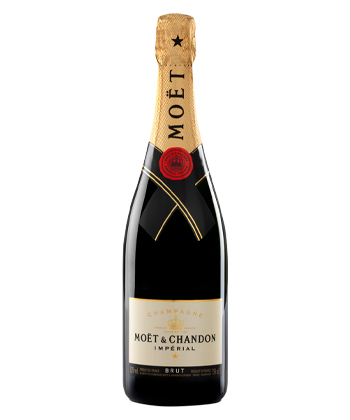For centuries, Champagne has been a symbol of refinement, luxury, and celebration. While sparkling wines can be made anywhere in the world, Champagne must come from the French appellation of the same name, a region revered for its chalky soils and cool climate.
Two prized Champagne houses, Moët & Chandon and Veuve Clicquot, have enjoyed immense success across the world. As one of the largest producers of Champagne, Moët & Chandon is sold in more than 150 countries and touts a history of famous admirers, from Napoleon Bonaparte and the Marquise de Pompadour, to tennis legend Roger Federer and Queen Elizabeth II (not to mention the global popularity of its vintage Champagne, Dom Pérignon).
Veuve Clicquot’s recognizable iconic yellow label (used on bottles of its signature “Brut” style) helped to popularize the brand, but a history of innovation, starting with a visionary woman at its helm and the house’s practice of remuage, or riddling, changed how Champagne is produced today.
Keep reading to learn more about some of the distinguishing characteristics of Moët & Chandon and Veuve Clicquot, two beloved Champagne houses.
Origin
Maison Moët was established in 1743 by Claude Moët, a wine trader from the city of Épernay. But it was Claude’s grandson, Jean-Rémy Moët who is credited with championing Champagne on a global scale. Nearly a century later in 1832, Claude’s great-grandson Victor Moët’s partnership with his brother-in-law Pierre-Gabriel Chandon de Briailles resulted in a merging of the two family names.
The Clicquot House was founded in 1772 by Philippe Clicquot, a Reims-based banker and textile merchant. In 1805, following the death of his son, Philippe’s daughter-in-law, Barbe Nicole Ponsardin, took over the family business and saved it from near bankruptcy. The house would become known as Veuve Clicquot, or “widow” Clicquot in English.
Production
As mentioned above, Madame Clicquot herself is credited with the invention of the riddling table, a board with holes in which bottles of sparkling wine are stored upside down and gradually turned, forcing dead yeast to settle into the neck for easy removal. The process, which is still employed today, effectively modernized the appearance of Champagne into a clear, sediment-free wine.
Both houses are known for having mastered the complex art of blending, in which grapes from a collection of vineyards from the region are combined into a specific assemblage, or cuvée. Moët & Chandon’s Moët Impérial, the brand’s signature label, is made from more than 100 wines, while Veuve Clicquot’s Yellow Label is blended with grapes sourced from up to 60 different crus.
Flavor
Moët Impérial is made with the region’s main grapes, Chardonnay, Pinot Noir, and Pinot Meunier, known as the “big three.” As VinePair writes, the blend “is both fruit-forward and elegant: fleshy soft fruit mingling with delicately nutty cereal notes.”
Veuve Clicquot uses all three grapes in its blends, but is known for its Pinot Noir-driven wines, a light-skinned grape that adds structure and body. According to The Drinks Business, the company’s flagship Yellow Label has a “rich and mellow profile,” with “buttery creamy bready characters … complemented by an apple-like sour note.”

Alcohol Content
When it comes to alcohol content, Moët Impérial and Veuve’s Yellow Label both come in at 12 percent ABV.
Use in Cocktails
Although one of the great joys in life is a glass of Champagne on its own, when used in a cocktail, it adds a delicate depth. Perhaps the most famous and simple iteration, the Champagne Cocktail, was first popularized in 1862 by bartender Jerry Thomas. It combines bubbles with a sugar cube that’s been soaked in Angostura bitters. A more potent elixir is the French 75, made with Champagne, gin, lemon juice, and sugar.
Why the Pros Love Each
In 2020, the trade publication Drinks International conducted a survey in which 106 bars were asked to name the Champagne brands they used most. The results were a surprise; coming in at first place for the best-selling and best- trending Champagne was Veuve Clicquot, which pushed out reigning champ Moët & Chandon.
For Lyon-based Caroline Conner, a virtual wine teacher at Wine Dine Caroline and a Master of Wine candidate, if pressed to choose between the two, Moët & Chandon would be her choice: “It’s a crisper style and cheaper than Veuve,” she says.
And for others, like Greg DeForest-Campbell, a sommelier and owner-operator of the 1897 Beekman House Bed and Breakfast in Dundee, N.Y., the value of Moët Impérial and Veuve Clicquot Yellow Label lies in their focus on consistency in style.
“You can walk into most any wine shop in the world, put down a not-unreasonable amount of money, and walk out with a quality bottle of Champagne,” he says. “This consistency, in a sense, is what Champagne is all about. It is, after all, a blending region.”
And while grower Champagnes or single-varietal blanc de blancs and blanc de noirs may be more exciting or current, DeForest-Campbell says, “they are not, at their essence, as quintessential to the central identity of Champagne as these blended house styles.”

